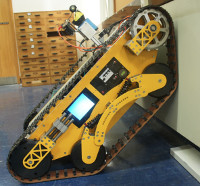G4 and XTAG-2
-
ale500
- Respected Member
- Posts: 259
- Joined: Thu Sep 16, 2010 9:15 am
G4 and XTAG-2
I would like to finally make a G4 stamp board (with the BGA144), and I was asking myself if the XTAG-2 dongle can program the G devices.
-
XMatt

- XCore Addict
- Posts: 147
- Joined: Tue Feb 23, 2010 6:55 pm
The XTAG-2 fully supports the G series devices with all functionality apart from XScope due to the link incompatibility between L and G series parts.
-
ale500
- Respected Member
- Posts: 259
- Joined: Thu Sep 16, 2010 9:15 am
Then, I go ahead with the design.
-
TSC

- Experienced Member
- Posts: 111
- Joined: Sun Mar 06, 2011 11:39 pm
Instead of using a G4, you could use two L2 devices linked together. They are a newer design, faster, have lower power consumption and their Xlink topologies are much more flexible than the G4 (not just a hypercube of 1, 2, 4, 16, 64).
There is something just like that from Synapticon called SOMANET C22, but I'd like to see an open hardware version of something similar.
There is something just like that from Synapticon called SOMANET C22, but I'd like to see an open hardware version of something similar.
-
ale500
- Respected Member
- Posts: 259
- Joined: Thu Sep 16, 2010 9:15 am
With 2 L2s will be evrything bigger.... I wanted just a 5x5 cm board with 2.54 mm spaced connectors... let's see...
Are the G devices then eol'd ?
Are the G devices then eol'd ?
-
segher

- XCore Expert
- Posts: 844
- Joined: Sun Jul 11, 2010 1:31 am
The G4 devices have some advantages over the L2 devices:
-- 70 I/Os per core, versus 44/40;
-- 4 external links per core, versus 2;
-- *much* faster inter-core communication;
-- 5V-tolerant I/O.
It is not true that you can only do hypercube topologies with the G4
devices: the manuals even show you how to build a simple line. It is
true that the L devices are slightly more flexible, but not hugely so;
it is mostly helpful for systems where you do not care so much about
the communication performance, but only that the devices are connected
_at all_: systems where you have few external links, and/or you use a
very sparsely connected topology (line, line of lines, etc.) An example
of a simple topology that is impossible to route optimally with L devices
(and with G as well) is where you have three devices, each connected
to the other two via one link.
The question whether the G devices are end-of-lined depends on what
you mean by that. XMOS certainly still sells them, and will probably
continue to do so as long as there is demand. On the other hand it is
pretty obvious that they consider it a legacy device. All this is just my
opinion, of course; if you want official (and better informed :-) ) word,
just ask XMOS.
-- 70 I/Os per core, versus 44/40;
-- 4 external links per core, versus 2;
-- *much* faster inter-core communication;
-- 5V-tolerant I/O.
It is not true that you can only do hypercube topologies with the G4
devices: the manuals even show you how to build a simple line. It is
true that the L devices are slightly more flexible, but not hugely so;
it is mostly helpful for systems where you do not care so much about
the communication performance, but only that the devices are connected
_at all_: systems where you have few external links, and/or you use a
very sparsely connected topology (line, line of lines, etc.) An example
of a simple topology that is impossible to route optimally with L devices
(and with G as well) is where you have three devices, each connected
to the other two via one link.
The question whether the G devices are end-of-lined depends on what
you mean by that. XMOS certainly still sells them, and will probably
continue to do so as long as there is demand. On the other hand it is
pretty obvious that they consider it a legacy device. All this is just my
opinion, of course; if you want official (and better informed :-) ) word,
just ask XMOS.
-
ale500
- Respected Member
- Posts: 259
- Joined: Thu Sep 16, 2010 9:15 am
I wanted to use the BGA144 version, with only 88 IOs, at least initially...
-
edschulz

- Junior Member
- Posts: 4
- Joined: Sun May 13, 2012 7:00 pm
Please elaborate on the G4 faster inter-core communication. I cannot see this from the posted XMOS documents:segher wrote:The G4 devices have some advantages over the L2 devices:
-- *much* faster inter-core communication;
L2: http://www.xmos.com/node/14249?version=latest
G4: https://www.xmos.com/download/public/XS ... 1B%29..zip
The effective data rates in the two documents match exactly.
Is your point that on-chip inter-tile communication is faster on G4 than off-chip link communication between L2 devices? If so, then how would we quantify that difference?
-
jarnot
- Member++
- Posts: 26
- Joined: Thu Apr 15, 2010 4:52 pm
I have had a lot of success using the XC-2 card as an ethernet based intelligent interface, and several of the points raised in this thread are relevant to my future choices. The G4 is heading towards becoming a legacy part, with links that are not compatible with the L-series devices, a slightly higher power consumption than necessary, XTAG-2 XScope incompatibility, and so on. The XC-2 has a nice form factor, and a reasonable amount of I/O -- which would be a little more convenient in some applications if a similar amount of I/O came from fewer cores. This brings up the question of whether a successor to the XC-2 is being planned, with a small form factor, ethernet, plenty of I/O (in a form factor that can easily be plugged into a motherboard), and a newer processor. An L2 based card similar to the XC-2 would be nice. Does anyone know if there are plans for such a successor to the XC-2?
-
segher

- XCore Expert
- Posts: 844
- Joined: Sun Jul 11, 2010 1:31 am
Yes, probably. Sorry I don't speak newspeak.edschulz wrote:Is your point that on-chip inter-tile communication is faster on G4 than off-chip link communication between L2 devices?
You can just measure it, of course! For the on-package link on L2 youIf so, then how would we quantify that difference?
get 50MB/s per link (you can gang up a few if you need more than that),
for G4 much higher (cannot measure it right now, devices not plugged
in, lazy, sorry).
